Today’s audiophile market offers plenty of amplifiers and DACs. There are also many device which integrate both stages to add convenience and reduce overall size. Chinese manufacturer Topping launched its latest device, the Topping DX7, last month. It offers both a DAC and an amplifier in a single aluminium shell, together with interesting features such as balanced inputs and outputs.
The Topping DX7 is a compelling device that competes with the likes of the audio-gd NFB28, the Schiit Jotunheim (with balanced DAC) and the Emotiva DC-1. There are obviously differences between them, but they all aim for a specific segment – a segment where the Topping DX7, the new flagship device from the Chinese manufacturer, can have a say.
Disclaimer: the Topping DX7 I got is a free sample. You can look on Topping’s site for additional information on the device.
TL;DR: recap
| Pros |
Cons |
| Modern design; aluminium with matte finish; OLED screen
Remote control Auto-on and auto-off if coupled with a PC Plenty of input and output options, balanced and single-ended Neutral sound signature |
Sensitive to radio interference and power noise
No way to select output in line-out mode High output impedance |
Rating: 9/10
Packaging & Acessories
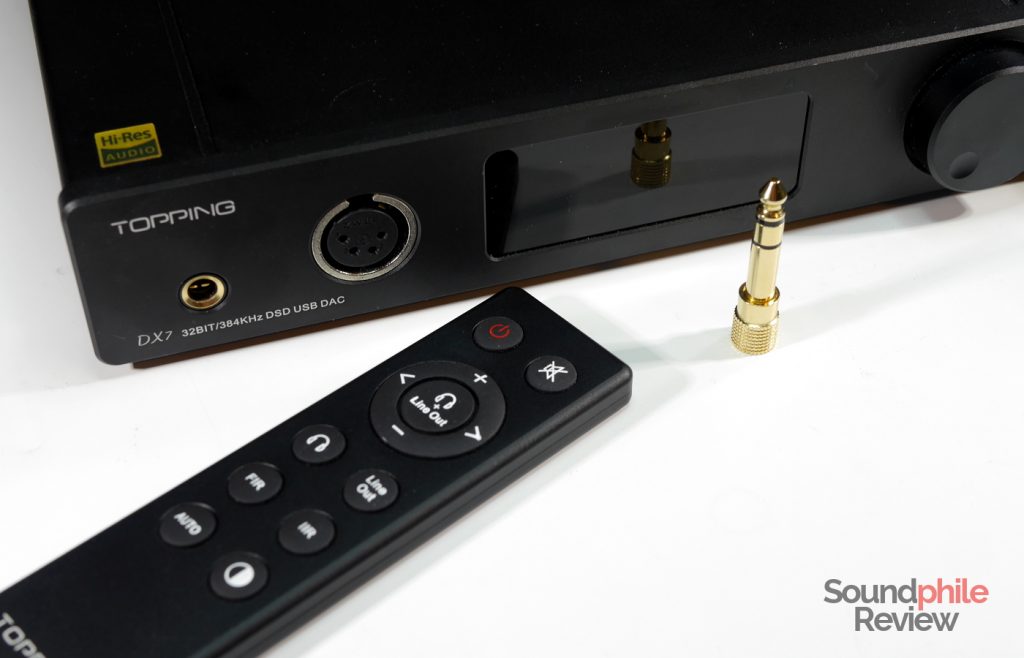
The Topping DX7 comes in a nice and sturdy cardboard box padded with plastic foam that prevents damages during transport. It contains the DX7 itself, the infrared remote, a 3.5 mm to 6.3 mm jack adapter, the power cord, a USB cord and a few leaflets (manual, warranty card, etc). There are no wires to connect the DX7 to other devices but the USB cable, so you will need to buy your own cables to connect speakers or other amplifiers.
Design & Build
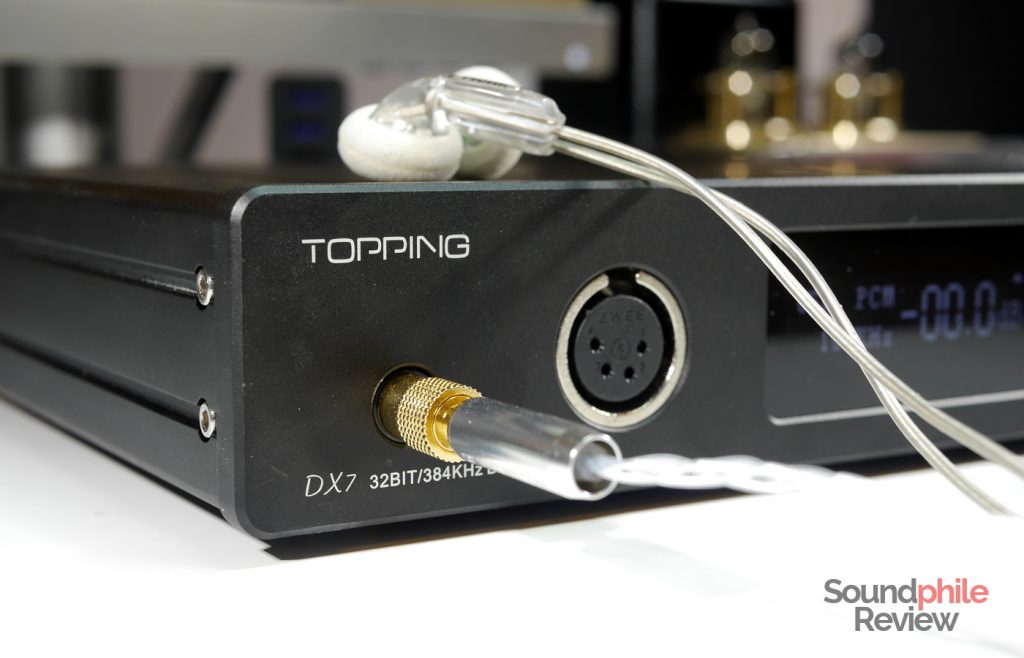
In terms of design, the Topping DX7 marks a departure from previous devices. It is much more understated and premium-looking. When compared to devices such as the Topping D30 or the Topping A30, the DX7 appears more solid, with sleeker lines and a refined finish. While it keeps the squared lines of previous devices, they are now countered by tapered edges. It is a device which could sit on a desktop as well as on a shelf in the living room.
The shell is made of aluminium, which has a finish similar to that of MacBook laptops. It is indeed good-looking and it reminds me of the Topping NX1s, too. It is 24.8 x 18.8 x 4.8 cm, weighing 1.9 kg. The volume knob is also made of aluminium and the only plastic part is the power socket on the rear. Even the remote is made of a single slab of aluminium!
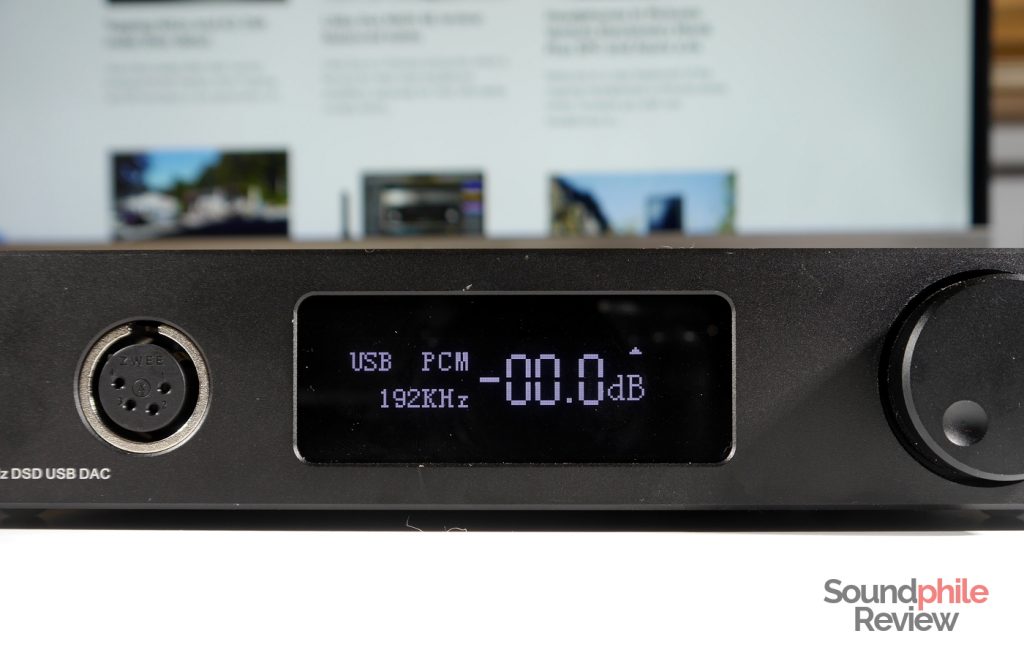
The main difference with the Schiit Jotunheim, the audio-gd NFB11 and many similar devices is the inclusion of an OLED screen (similarly to the new Monoprice THX amp). Instead of using a physical switch to cycle through inputs and outputs, the DX7 uses internal circuitry which can be controlled by the remote or by pressing the volume knob. The OLED screen allows one to see the current settings (i.e. USB input, headphone output, volume) and information on music being played (i.e. PCM, 192 kHz).
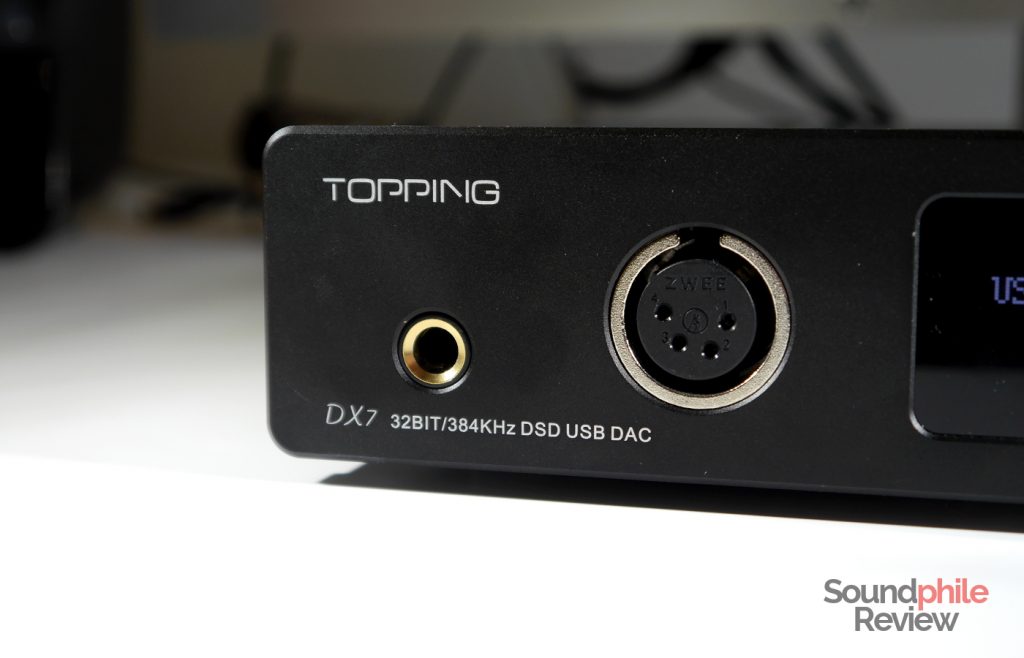
The front hosts a 6.3 mm jack socket, a XLR4 connector, the aforementioned OLED screen and volume knob; the left side is home to the voltage selector (110 V / 220 V); the back is where the power input, power switch and input and output connectors are located. Input ports include USB, optical, coaxial and AES (XLR3); output is done through two XLR3 connectors, two RCA connectors and a coaxial connector.
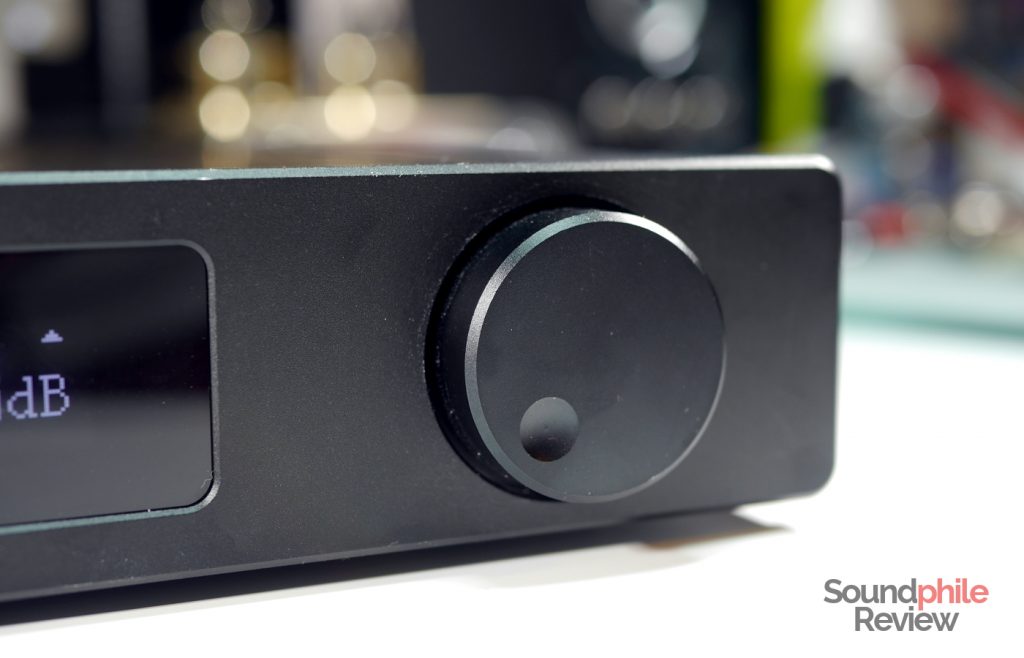
The volume knob clicks when rotated and has no boundaries (i.e. no min nor max), so that it does not move when volume is controlled by the remote.
Features & Specs
The Topping DX7 is the most feature-pack device the firm has launched yet. This is not only due to the fact that it is the first device to include both a DAC and an amp stage, but also because it offers a slew of options. Whether you want to use it as a desktop headphone amplifier or as a DAC to feed speakers or amplifiers, it has you covered.
It works with Windows and Linux, and it should work with macOS too (I do not own a recent enough Mac to test it). Linux detects the device automatically and no driver install or configuration is needed. Windows needs drivers, which can be downloaded on the manufacturer’s site.
Topping DX7
|
| Input range | USB: 16 – 32 bit / 44.1 – 384 kHz, DSD64, DSD128 Optical, AES, coaxial: 16 – 24 bit / 44.1 – 192 kHz |
| Suitable headphones impedance | 16 – 300 Ω (6.3 mm jack)
32 – 600 Ω (XLR4) |
| Output impedance | Headphone out:
Line out:
|
| Maximum output power | 640 mW (32 Ω, 6.3 mm jack) 110 mW (300 Ω, 6.3 mm jack) 420 mW (300 Ω, XLR4) 210 mW (600 Ω, XLR4) |
| Frequency response | 20 – 20,000 Hz ± 0.01 dB (all outputs) |
| THD+N (@1 kHz) | < 0.003% (33 Ω, 300 mW, 6.3 mm jack) < 0.0007% (300 Ω, 200mW, XLR4) |
| SNR | > 113 dB (A-weighting) |
| Crosstalk | -130 dB (RCA out, XLR out) -83 dB (6.3 mm headphone output) -110 dB (balanced headphone output) |
The DAC Topping used is the ESS Sabre 9018K2M, which isn’t the “latest and greatest” but still holds its own against more recent offerings. They did not disclose which amplifier chip they used.
Power output is decent, though it is far from the peak of the Schiit Jotunheim. It should be enough to drive most headphones with ease. Even though the advantage of using balanced lines is not always clear and is a matter of debate among audiophiles, the vastly superior output power from the balanced output the Topping DX7 provides makes the case for it.
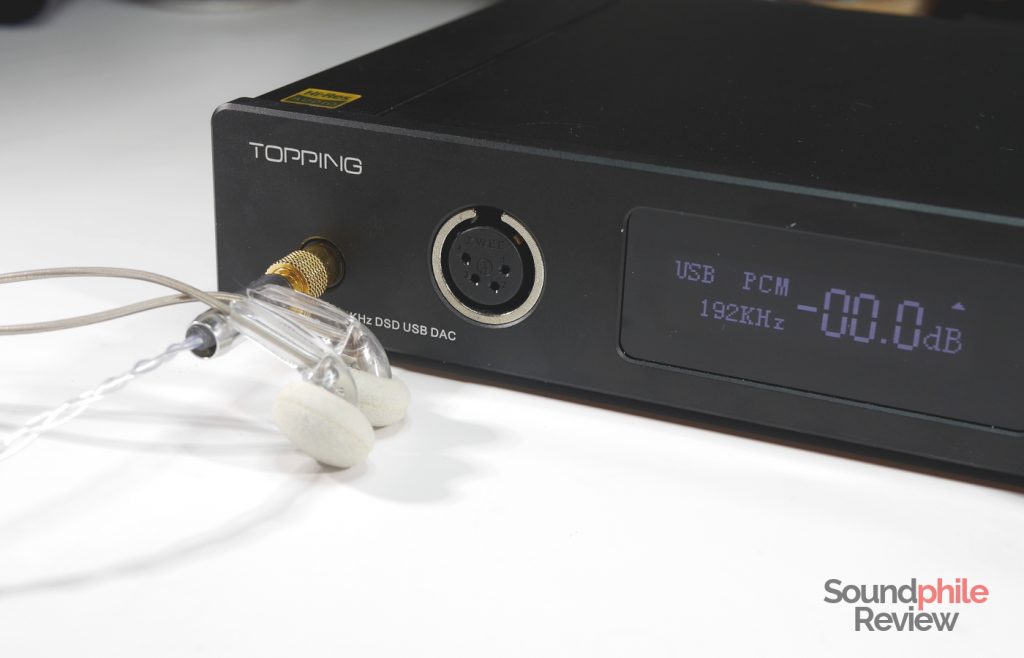
The problem most Topping products suffer from – high impedance on headphone outputs – is there on the DX7, too. That means the DX7 is better used with high-impedance headphones, even though it supports 16 Ω IEMs.
Although it supports DSD, Topping’s implementation is DOP – DSD Over PCM. This means that the DSD signal is incapsulated to PCM packets and then used, so it is not a native DSD implementation.
Volume control is discrete rather than continuous, so there are pre-set volume levels you can choose instead of a continuous modulation as the one that happens in devices such as the previously-reviewed Topping A30. The volume goes from -100 dB to 0 dB; from -100 dB to -50 dB it progresses by 1 dB with each step, while after that mark it goes up by 0.5 dB with each step.
The Topping DX7 has a remote which is used to select the desired inputs and outputs. It also allows to select different modes, too: pressing the “headphones + line out” button should lead to the DX7 acting as both DAC and headphone amplifier, presumably using line out when headphones are not plugged in; the “headphones” button should only leverage the amplifier stage, excluding the DAC; the “line out” button, conversely, makes it only work as a DAC so you can use any other amplifier or powered speakers (I used it with the Little Dot MKIII SE and with the Creative T30 Wireless speakers). This means you can use monitors such as the JBL LSR305, which use XLR cables, or balanced amplifiers in addition to single-ended amplifiers and speakers.
Now, that’s the theory. Practice is different, though. I could not find any differences between the “headphones + line out” and the “headphones” modes, since they both make the DX7 work as DAC and headphone amplifier. Even when headphones are not plugged in and “headphones + line out” mode is selected, there’s no output from line out. Go figure. It seems like I got it wrong: there is in fact output when selecting the “headphones + line out” mode, and it allows you to control volume from the DX7. The volume is so low, however, that I had to crank it up to insane levels on my speakers to get it working. It may be ideal for monitors with maxed up volume which is then controlled by the DX7. How good this may be for sound quality, however, I am not certain about.
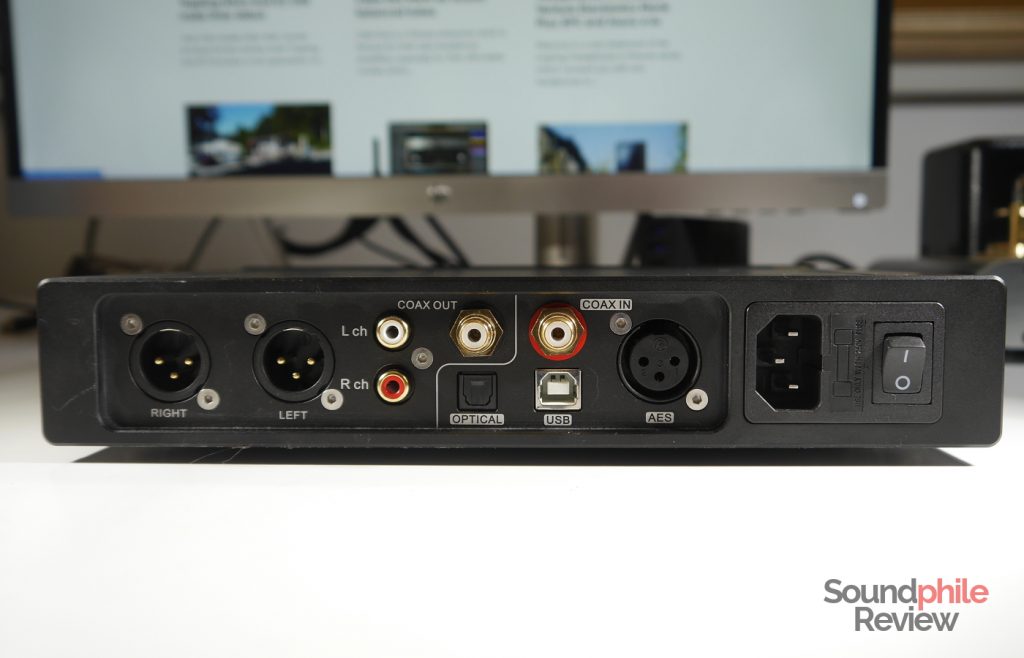
Pressing the left and right buttons switches inputs. You can select USB, coaxial, AES (XLR cable) and optical. The Topping DX7 can therefore be used with a variety of different devices, although it lacks RCA input to be used as an amplifier only.
When “Line Out” mode is selected, the output goes to every connected device – in my case, I connected the Little Dot MKIII SE to the balanced outputs and the Creative T30 Wireless powered speakers to the RCA outputs. There was no way to select the desired output, so I could not switch between them. There’s also no way to adjust the volume when in line out mode, so it does not really act as a preamp.
Much like the Aune M1s, the DX7 offers a simple “equalizer” to slightly change the way music is portrayed. The FIR filter is made of three different options: slow, fast and mini. The difference between them is ever so small; it requires extremely critical listening to discern differences. The “slow” filter makes bass a bit more prominent, the “fast” filter increases transiet response and the “mini” filter is neutral. There may also be additional differences, but I wasn’t able to spot them using the equipment I have.
IIR filters, on the other hand, offers four different options: 47k, 50k, 60k and 70k. Topping says they are only used for DSD files, so you won’t hear any difference while playing PCM files.
The “Auto” button makes the Topping DX7 automatically wake up and shut down when it detects the computer is booting up or powering off. This way the user does not need to manually switch on power. This feature works perfectly under Windows, but the device inexplicably powers up and subsequently shuts down when Linux is booting up.
Last but not least is the brightness button: it allows one to switch between low-brightness and high-brightness modes, so that the characters appear white in the latter case and greyish in the former one. They are visible whichever mode one selects, though the high brightness setting may result in easier-to-read characters when the environment is flooded with light.
Sound
I paired the Topping DX7 with a bunch of different headphones: the RHA T20i, Meze 99 Classics, Venture Electronics Asura 2.0s, Venture Electronics Monk Plus, HiFiMAN RE-00, KZ ZST, Superlux HD668B and a few others. As for the music, I used FLAC files (mostly 16 bit / 44.1 kHz, a few 24 bit / 192 kHz) with a few MP3s (320 kbps) here and there.
Sound is neutral and clean, with lots of details. It has no detectable emphasis on any frequency, a fact which, in turns, means it should pair well with most headphones without introducing unwanted colouring and changing the behaviour of the headphones.
It lacks the lush and vivid nature of the Little Dot MKIII SE, but it offers a no-frills, accurate sound reproduction which is pleasant and faithful. It does sound good, as it’s analytical and precise.
Instrument separation is good, though it could see some improvements. Sound is coherent and imaging is good; soundstage is wide enough though it is not the deepest I’ve heard. Transient response is fast and accurate, so you will feel that striking effect when listening to percussions (i.e. “The Battle” from the Master and Commander soundtrack).
I could not hear any distortion using headphones I own, not even when cranking up the volume to unsafe levels. I think this implies Topping did a good job in the implementation of both the DAC and the amplification stages: the output is clean and well-controlled.
The Topping DX7 seems to be very sensitive to power noise: there is a constant hiss in the background which is especially audible with low-impedance, high-sensitivity headphones. The left earpiece is also constantly popping at regular intervals when the “line out + headphones” mode is selected, while this does not happen when the “headphones” mode is active. It is also prone to displaying interference from radio signals such as the ones coming from a nearby (< 50 cm) cell phone.
I can hear no differences when using the single-ended output and the balanced output: the only obvious difference is the fact that the Topping DX7 has a larger power output when using the balanced connection. There is also a bit less noise caused by power; it is still notable, though, so this is just a relative advantage.
Final Thoughts
The Topping DX7 is an all-in-one device which has everything one needs – DAC, headphone amp, lots of input and output options – in a compelling package. While it does not seem to be the best in its category in any aspect (i.e. the Schiit Jotunheim has more power output, the audio-gd NFB28 has the more recent ESS Sabre 9038 chip, etc), it is a jack of all trades which does its job well.
It is very sensitive to noise coming from the power line, so sensitive earphones will show persistent hissing which can be fatiguing. The output impedance is also high, which leads to high-impedance headphones being better driven than low-impedance portable headphones. It could see some improvement, that’s for sure.
That said, I found the overall experience very satisfying and pleasant; the DX7 is a one-stop device for the needs of most people – even those looking for a higher-end device than other offerings such as the notorious Schiit stack or Topping’s very own stack (Topping D30 + Topping A30). What’s more, it offers balanced inputs and outputs which come in rather handy in case one uses monitor speakers (i.e. JBL LSR305) or has headphones with a balanced connector.
The Topping DX7 is not for everyone, though: the most demanding audience may deem its flaws excessive. Less demanding people, however, may find enjoyment in the compromise. I for one think compromise is not excessive here and the DX7 is worth its price and maybe even more.
The Topping DX7 sells for $399.99.

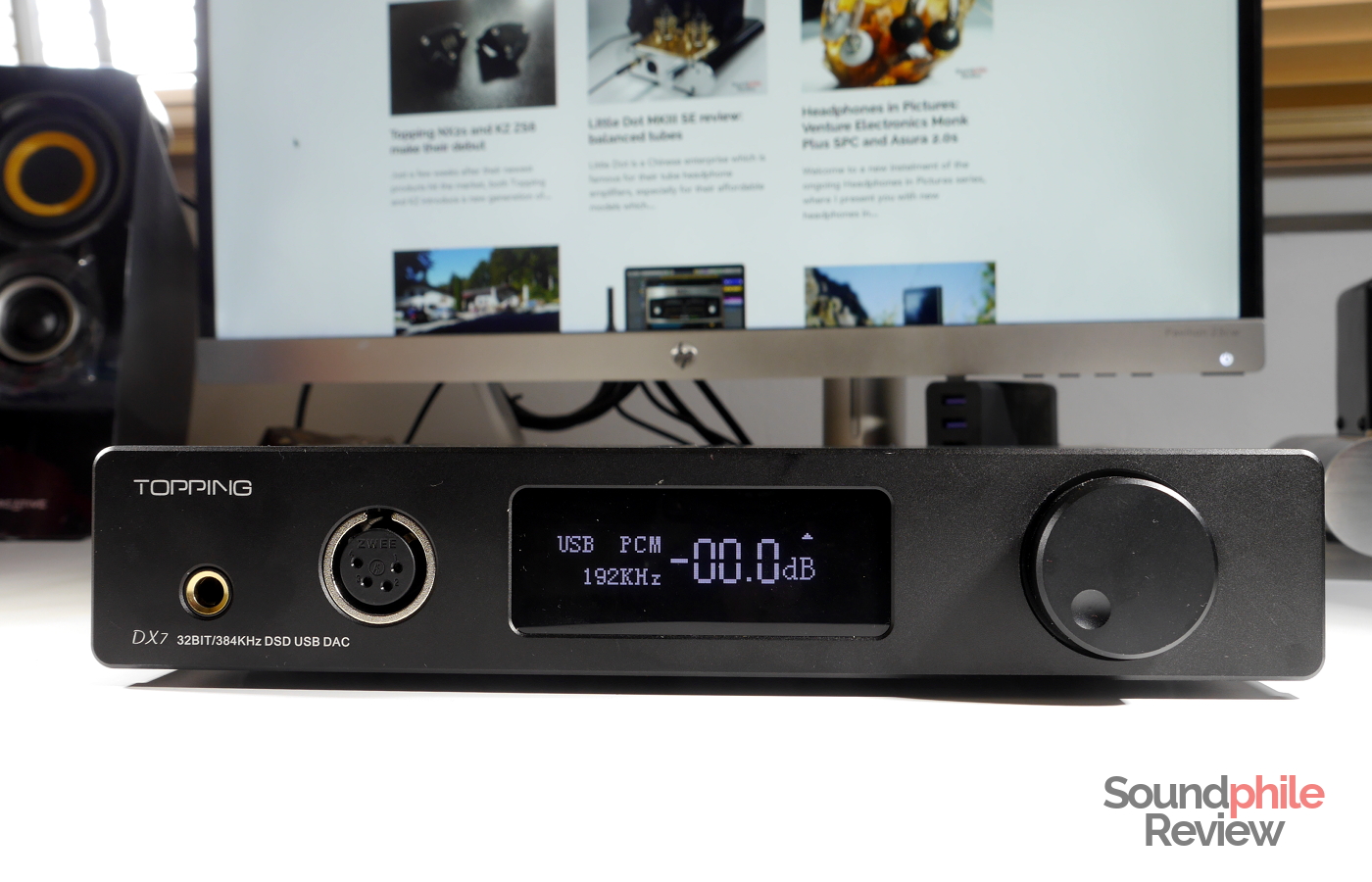


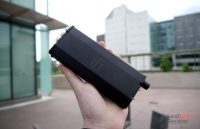
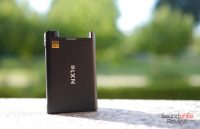
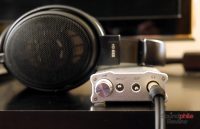


Thank you for trying this in Linux. So few audiophile reviewers ever mention it at all.
Regarding the on/off issue in auto mode during boot, does it power up, power down and then power back up again or does it stay off after powering down?
I have a topping VX1 currently which stays off until the kernel itself loads (ie works fine). I’m curious if perhaps the firmware of the DX7 is turning on on with USB voltage and then turning off again in the boot loader when it can’t get USB data.
Would be great if you could mention which Linux distribution you tested with along with kernel. Thanks for the review.
Hi! Thank you for your comment!
I use Linux Mint 18.2, currently with kernel 4.13.3. I used kernels 4.10, 4.11 and 4.12, too. The DX7 powers up during boot (after GRUB loads the Linux kernel), then it shuts down after ~10 seconds. It sometimes stays off, sometimes on – I have yet to understand what is the reason for this behaviour, as it is consistent. I will do further testing and dig in the logs, maybe something will come out of it!
Hi Riccardo,
italian reader here writing in English just to mantain the international profile of the site/blog (btw never understood how to define this kind of webplace… I guess ‘blog’ is a more appropriate term)
Well, let’s return to the topic; as the DX7 has been discontinued, so I’ve understood, and very difficult to find on sale, do you think to manage a review of the new iimproved DX7S in the next future when it willbe ready available ? The DX7 it’s a great product (the instrumental measures I’ve read @audiosciencereview (dont know if posting a weblink is possible) confirm too, but I’m curious about the DX7S… how it performs and if the little problems showed by the DX7 are now gone. Rumours say its price should be just 20/25% more so I think the wait could be worth it.
All my compliments for the great review (my first reading here) and keep up the good work.
Ciao
Marco
Hey Marco,
Yes, “blog” is perfectly fine in this case! Also, thank you for your compliments.
I don’t know about it yet – I am currently in the process of reviewing the NX4 DSD, the latest portable DAC/amp by Topping. I’ll ask them whether it will be possible to review the DX7s, too.
What I can tell you about the DX7s is that it will not feature a remote and that’s kind of a shame, as it was one of the best features – at least in terms of usability – on the DX7. The main issues, such as high output impedance, also seem to be still there, so it’s a bit of a mixed bag. I’ll update you on whether I will be able to review the product as soon as I have news!
Hi Riccardo – is there anyway to use the DX7 balanced outputs on the rear panel directly into an amplifier without any volume control capabilities? IOW – can the DX7 function as a DAC/Preamp using the remote control to adjust volume when one isn’t using headphones? Even though the unit is obsolete now, I am presuming the DX7s will behave identically in this regard. Thanks
Hey there!
If I understood it correctly – yes, you can. You can either use the DX7 (and the DX7s, I guess) as a fixed-output device, or as a variable-output device. A practical example: I used it with fixed output volume when reviewing the iFi micro iCAN SE, and I am using it with variable output volume with the Little Dot MKIII SE as I am writing this (that amp has so much power it’s almost insane…). The variable-output mode is useful if you feed powered speakers, as an example (e.g. JBL LSR305 or IK Multimedia iLoud Micro Monitor).
I hope this answers your question.
> Although it supports DSD, Topping’s implementation is DOP – DSD Over PCM. This means that the DSD signal is translated to PCM and then used, so it is not a native DSD implementation.
Your explanation is misleading. DOP means sending DSD packets wrapped within a PCM format. PCM is only used as the carrier of the data. When decoding the USB interface (XMOS chip in this case) unwraps the data and send DAC Chip (ES90x9 in this case) raw DSD data. This is very different from your understanding that DOP “translate” DSD to PCM format. “Translate” means convert DSD to PCM format (for instance, convert dsd64 to 88.2khz /32bit), which does not happen at all.
On the decoding side, Dop is identical to native DSD, as the ES90x9 chip sees exactly the same data at the same rate. The only drawback is DOP packet is heavier than native, as there’re a few extra bits used to identify it’s a DSD data transferred to the DAC for every frame over the USB.
Hi,
You are indeed right. Thank you for pointing out the issue – I think I read some wrong explanations or did not understand them correctly.
Hi Riccardo
Thanks for the excellent review. I have a couple questions, though.
1-Did you test the DX7 as just a DAC and compare to any other DACs?
2-The DX7s is now out. Have you tested it? As a DAC/HA or as DAC?
Thanks
Hi! I have been actually using it mostly as a DAC as of late; the only other DAC I have on hand to compare it to is the D30 by Topping. I honestly cannot hear any big difference between the two; in terms of functionality, there is a significant improvement in user experience due to the ability of the DX7 to alter the output volume in DAC mode.
I have not tried the DX7s and I do not think I will be able to at this point.
Hello!
Riccardo, you say, it’s not deepest soundstage. Can you recommend product with deepest soundstage? It’s all I need on my setup. Deep and wide soundstage.
Hi Vadim,
The amplifier with the largest soundstage I have found is the Little Dot MKIII SE, which is however a tube amplifier (review: https://www.soundphilereview.com/reviews/little-dot-mkiii-se-review-1045/). The iFi micro iCAN SE is my second choice and it is solid-state (review: https://www.soundphilereview.com/reviews/ifi-micro-ican-se-review-1480/).
hi, i want to ask something. if i use DAC+HP mode, when i set the dB to a high value (for example -5dB), on my speaker its good but when i connect a headphone its so loud(this mean my HP get a very big output power from the dx7s). what do you thing about this? one more question, if i use DAC+HP mode and only use a speaker (HP not connected), can it break the HP output port or reduce the HP output port quality as year/as time goes by, because its always transfer a big output power?
Hi there! “DAC+HP” is just a way to name the preamplifier mode. It works without using the headphones – in fact I’ve been using it like that most of the time recently. It is made to work without headphones plugged in, so you won’t damage anything.
Also, that mode uses a single volume setting for all outputs, so headphones are indeed going to be really loud at -5 dB. You can unplug them if you are going to use speakers, and then use the headphones mode if you want to only set volume for headphones (though that will cut off output to speakers).
“Although it supports DSD, Topping’s implementation is DOP – DSD Over PCM. This means that the DSD signal is translated to PCM and then used, so it is not a native DSD implementation.”
You might want to do a bit more research on this. DoP has nothing to do with translating direct stream digital to pulse code modulation. You’ve misunderstood how this works.
Yeah, another reader pointed that out and I forgot to edit the article – sorry about that. It’s now been corrected though! 🙂